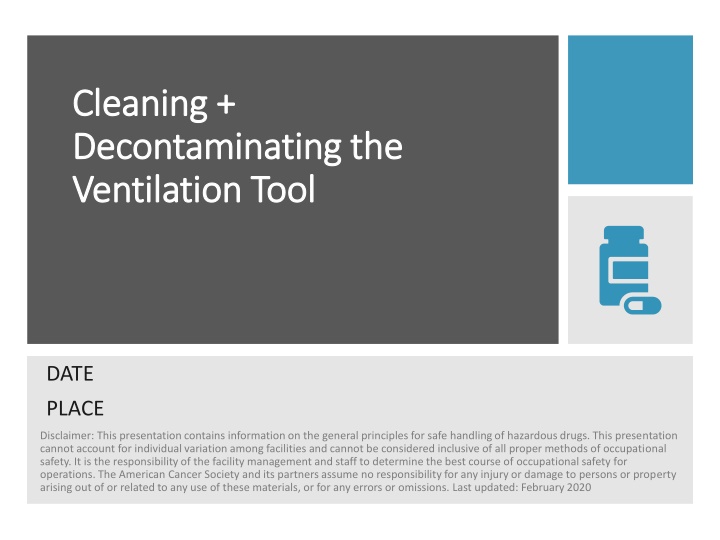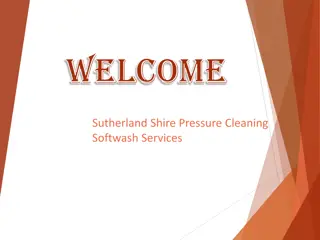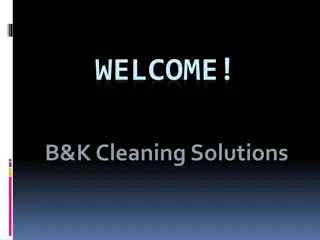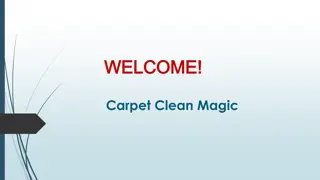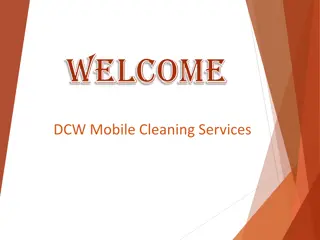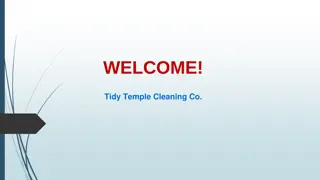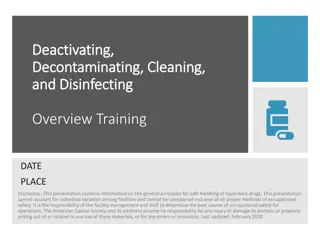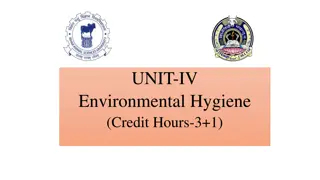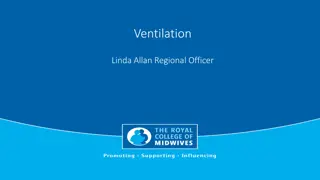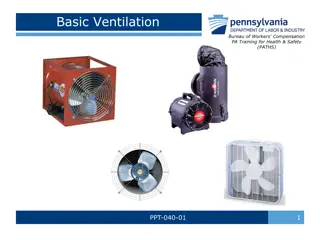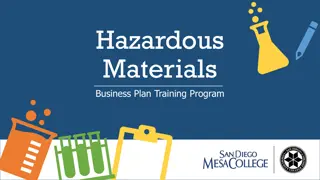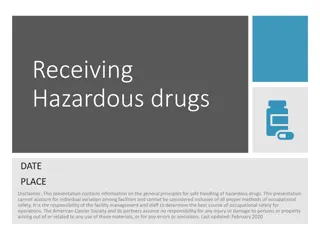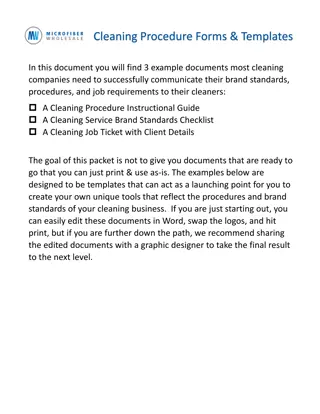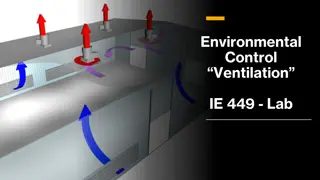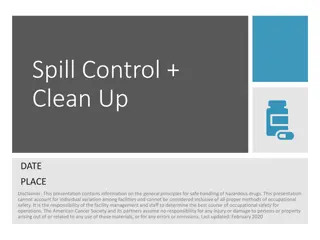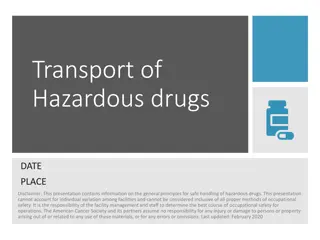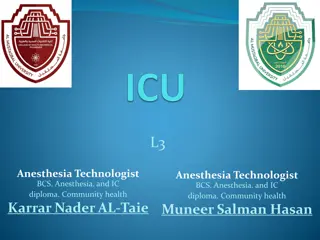Safe Handling of Hazardous Drugs - Ventilation Tool Cleaning Procedures
This presentation outlines the proper procedures for cleaning, disinfecting, and organizing ventilation tools, emphasizing the importance of trained operators following written protocols. It covers waste handling, documentation, and the use of personal protective equipment (PPE) for occupational safety. Additionally, it provides guidance on cleaning biosafety cabinets (BSC) and maintaining sterility in healthcare settings.
Download Presentation

Please find below an Image/Link to download the presentation.
The content on the website is provided AS IS for your information and personal use only. It may not be sold, licensed, or shared on other websites without obtaining consent from the author.If you encounter any issues during the download, it is possible that the publisher has removed the file from their server.
You are allowed to download the files provided on this website for personal or commercial use, subject to the condition that they are used lawfully. All files are the property of their respective owners.
The content on the website is provided AS IS for your information and personal use only. It may not be sold, licensed, or shared on other websites without obtaining consent from the author.
E N D
Presentation Transcript
Cleaning + Cleaning + Decontaminating the Decontaminating the Ventilation Tool Ventilation Tool DATE PLACE Disclaimer: This presentation contains information on the general principles for safe handling of hazardous drugs. This presentation cannot account for individual variation among facilities and cannot be considered inclusive of all proper methods of occupational safety. It is the responsibility of the facility management and staff to determine the best course of occupational safety for operations. The American Cancer Society and its partners assume no responsibility for any injury or damage to persons or property arising out of or related to any use of these materials, or for any errors or omissions. Last updated: February 2020
The cleaning, disinfection, and organizing of the ventilation tool is the responsibility of trained operators (generally pharmacists and technicians) following written procedures. 2
Training Modules + Learning Objectives List procedure for cleaning a biosafety cabinet (BSC). Cleaning Decontamination List procedure for decontaminating a BSC. List waste handling steps. Describe recommendations for logging cleaning and decontamination activities. Waste Handling + Documentation 3
Cleaning the Ventilation Cleaning the Ventilation Tool Tool
PPE An N95 respirator Disposable Gown Goggles Protective Gloves Wear appropriate PPE for cleaning and decontaminating work. Reference 1 5
Cleaning a BSC is an important function in terms of both containment and sterility 6 This Photo by Unknown Author is licensed under CC BY-SA
If the BSC runs continuously when should it be cleaned? Start of the day andat regular intervals OR End of the day For a 24-hour service, clean BSC 2-3 times daily Reference 1 7
Purge Room of Air When BSC is turned off Clean Disinfect Reference 1 8
When BSC is turned off: Less than 24 hours Two-minute start-up time is sufficient More than 24 hours Disinfect chamber and wait 10 minutes Reference 1 9
Procedure for cleaning the BSC: Clean from upstream to downstream Wipe in a continuous motion Wipe the surface 3 1 2 When a corner is met, S curve Continue with fixtures Cleaning Complete 5 6 4 Do not use the hood for at least 5 minutes Do not remove the sharps container 7 Reference 1 10
Detergent, sterile water for irrigation, and disinfectant bottles should be placed on a plastic backed disposable liner outside of the BSC when not in use. 11 Reference 1 This Photo by Unknown Author is licensed under CC BY
Decontamination of the Decontamination of the Ventilation Tool Ventilation Tool
When should you decontaminate the BSC? Any time a cytotoxic spill occurs Before and after certification At least weekly If the ventilation tool is moved Voluntary interruption 13 Reference 1
Procedure for Routine Decontamination of BSC Wipe from top to bottom Repeat using sterile water Finish by disinfecting 1 2 Wipe top and front grills with alcohol- dampened towel Decontaminate both sides of window Pull the viewing window down Discard outer pair of gloves and used wipers Decontaminate the perimeter of the opening Thoroughly wash protective eye wear Reference 1 14
The decontamination procedure should be completed at the end of the day whenever possible. If it must be completed during the day, the BSC shall be allowed to run for 30 minutes to purge before using for aseptic preparation. Reference 1 15
Decontamination Decontamination after biological after biological product product If a biological product is prepared in the ventilation tool, the tool should be decontaminated following preparation. The use of one cabinet to prepare both cytotoxics and BCG vaccine is NOT recommended Reference 1 16 This Photo by Unknown Author is licensed under CC BY-SA-NC
Decontamination before admixing The ventilation tool should be decontaminated before admixing non- cytotoxics if it has not been decontaminated since it was last used for admixing cytotoxics. The use of one cabinet to prepare both cytotoxics and non-cytotoxics is not recommended Reference 1 17
Decontamination of Sump The lower part of the BSC should be cleaned at least once a week to reduce the contamination level in the BSC. The fan motor (blower) should not be turned off only while cleaning the lower part of the hood (sump), Some BSCs have a screen on the fan to prevent anything from being sucked up Reference 1 18
Decontamination of Sump (a) Lean on back surface of BSC, or (b) Use stainless steel wire to suspend or Raise Work Tray (c) Use stainless steel prop to hold up To prevent back strain when decontaminating a 1.8m (6 foot) BSC, two people should lift and replace the work tray Reference 1 19
Decontamination of Sump DECONTAMINATE WITH DETERGENT RINSE WITH STERILE WATER FOR IRRIGATION DISINFECT THE WORK TRAY WITH ALCOHOL 20
Waste Handling + Waste Handling + Documentation Documentation
Waste Handling Waste generated throughout the cleaning or decontamination procedures should be: Collected in suitable plastic bags Sealed and wiped inside the ventilation tool Removed with minimal agitation Reference 1 22
Documentation Record on the quality control log when the daily cleaning/disinfection, weekly decontamination, and monthly sump cleaning is done Reference 1 23
24 1. Connor T, McLauchlan R, Vandenbroucke J. ISOPP Standards of Practice: Safe Handling of Cytotoxics. J Oncol Pharm Pract. 2007;13(1) References
